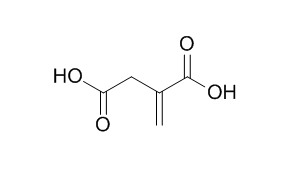Itaconic acid
Itaconic acid (IA) is an unsaturated dicarbonic organic acid. It can easily be incorporated into polymers and may serve as a substitute for petrochemical-based acrylic or methacrylic acid. It is used at 1–5% as a comonomer in resins and also in the manufacture of synthetic fibres, in coatings, adhesives, thickeners and binders.
Inquire / Order:
manager@chemfaces.com
Technical Inquiries:
service@chemfaces.com
Tel:
+86-27-84237783
Fax:
+86-27-84254680
Address:
1 Building, No. 83, CheCheng Rd., Wuhan Economic and Technological Development Zone, Wuhan, Hubei 430056, PRC
Providing storage is as stated on the product vial and the vial is kept tightly sealed, the product can be stored for up to
24 months(2-8C).
Wherever possible, you should prepare and use solutions on the same day. However, if you need to make up stock solutions in advance, we recommend that you store the solution as aliquots in tightly sealed vials at -20C. Generally, these will be useable for up to two weeks. Before use, and prior to opening the vial we recommend that you allow your product to equilibrate to room temperature for at least 1 hour.
Need more advice on solubility, usage and handling? Please email to: service@chemfaces.com
The packaging of the product may have turned upside down during transportation, resulting in the natural compounds adhering to the neck or cap of the vial. take the vial out of its packaging and gently shake to let the compounds fall to the bottom of the vial. for liquid products, centrifuge at 200-500 RPM to gather the liquid at the bottom of the vial. try to avoid loss or contamination during handling.
Phytomedicine.2021, 93:153789.
Biochem Pharmacol. 2023, 210:115463.
Plant Cell, Tissue and Organ Culture (PCTOC)2020, 143, 45-60(2020)
LWT2021, 138:110397.
Int J Cosmet Sci.2022, doi:10.1111/ics.12827.
Molecules.2023, 28(7):3039.
bioRxiv-Pharm.&Toxi.2022, 2022.481203.
Biomed Pharmacother.2024, 179:117410.
World J.Traditional Chinese Med.2024, 10(3):370-382
Biorxiv2019, 10.1101
Related and Featured Products
Applied Microbiology and Biotechnology, 2001, 56(3-4):289-295.
Biotechnological production of itaconic acid.[Reference:
WebLink]
METHODS AND RESULTS:
Itaconic acid (IA) is an unsaturated dicarbonic organic acid. It can easily be incorporated into polymers and may serve as a substitute for petrochemical-based acrylic or methacrylic acid. It is used at 1–5% as a comonomer in resins and also in the manufacture of synthetic fibres, in coatings, adhesives, thickeners and binders. The favoured production process is fermentation of carbohydrates by fungi, with a current market volume of about 15,000 t/a. Due to the high price of about US$4/kg, the use of IA is restricted.
CONCLUSIONS:
At present, the production rates do not exceed 1 g l–1 h–1, accompanied by product concentrations of about 80 g l–1. New biotechnology approaches, such as immobilisation techniques, screening programmes and genetic engineering, could lead to higher productivity. Also, the use of alternative substrates may reduce costs and thus open the market for new and increased applications.
Biotechnology Letters, 1985, 7(3):167-172.
Itaconic acid production by immobilizedAspergillus terreus from xylose and glucose.[Reference:
WebLink]
METHODS AND RESULTS:
Aspergillus terreus NRRC 1960 spores were entrapped in calcium alginate gel beads or alternotely the fungal mycelium was immobilized either on Celite R-626 or in agar gel cubes, and the biocatalyst was employed both in repeated batch and in continuous column reactors to produce Itaconic acid from D-xylose or D-glucose. The highest Itaconic acid yield obtained in a submerged culture batch fermentation was 54.5% based on total initial glucose (55 g/l) with a volumetric productivity of 0.32 g/l h, and 44.8% from xylose (67 g/l) with a productivity of 0.20 g/l h. In a repeated batch fermentation mycelium immobilized in agar gel had a productivity of 0.112 g/l h, and mycelium grown from spores immobilized in calcium alginate gel 0.06 g/l h, both from xylose (60 g/l).
With the best immobilized biocatalyst system used employing Celite R-626 as a carrier, volumetric productivities of 1.2 g/l h from glucose and 0.56 g/l h from xylose (both at 60 g/l) were obtained in continuous column operation for more than 2 weeks.



